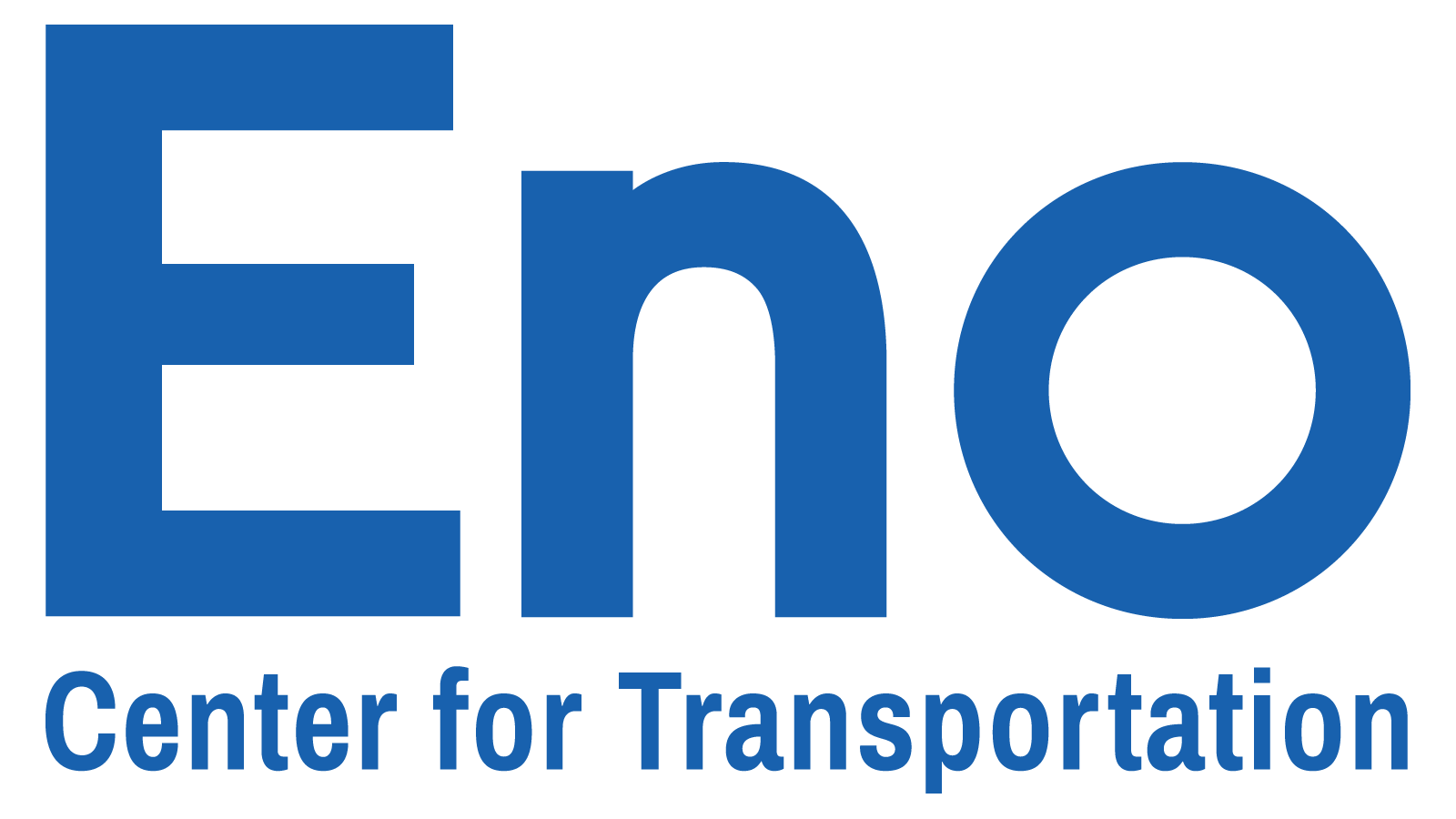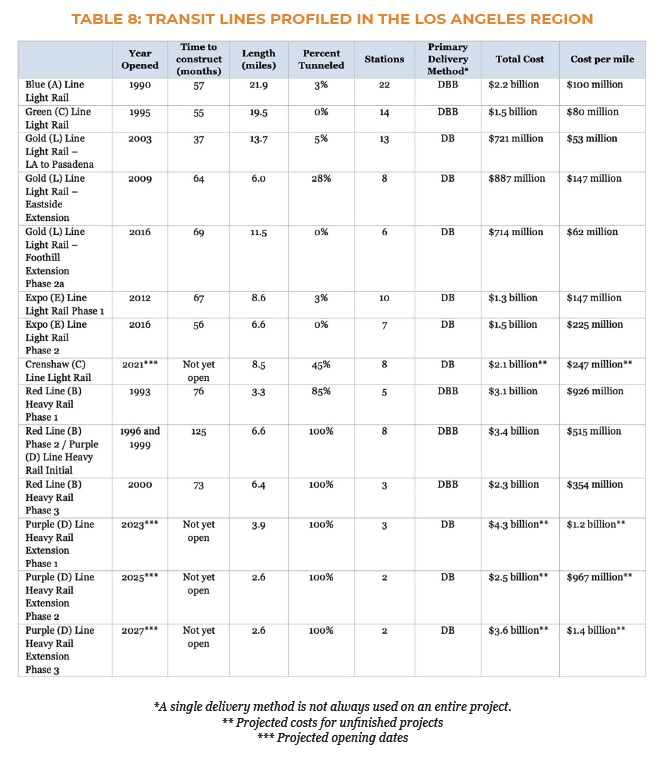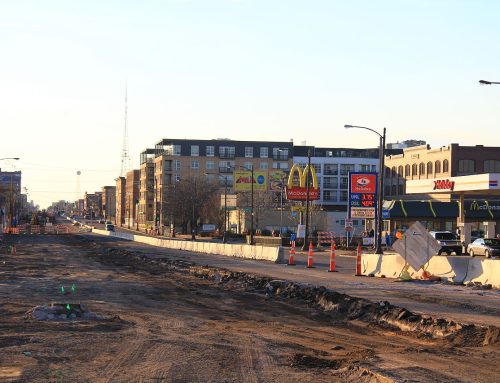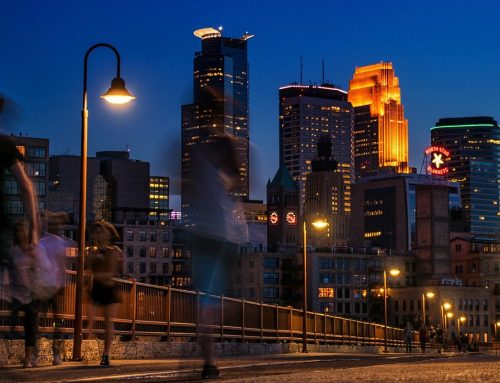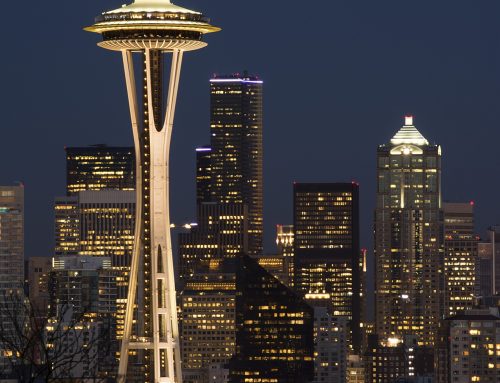Los Angeles
Metropolitan Los Angeles is currently undergoing the most ambitious capital expansion plan in the United States. Since 1990, the region has invested more than $20 billion in construction, built more than 104 miles of rail transit, and is currently extending and adding several new lines to its system. Los Angeles Metro’s Metro Rail system consists of two heavy rail subway lines and four light rail lines, spanning 98 miles of rail and having 93 stations.
The Los Angeles region provides a useful case study given its robust pipeline of projects and recent experimentation with different delivery methods that has allowed it to build out sizeable in-house management teams. However, cumbersome standards, complicated utility relocations, low tolerance for community disruption, and persistent requests for betterments from municipalities have contributed to delays and challenges in delivering projects.
Table of Contents
Governance Overview
The Los Angeles County Metropolitan Transportation Authority (LA Metro) is the primary agency responsible for planning and executing the expansion of the region’s light and heavy rail system. The agency was formed in 1993 after the legislature merged the LA County Transportation Commission and Southern California Rapid Transit District and serves as a transportation planning, coordinating, designing, building, and operating agency for Los Angeles County.
LA Metro is governed by a 14 member board of directors including members from the county and several local jurisdictions. More than 10 million people are spread out among L os Angeles County’s 88 municipalities. These municipalities are stakeholders on pro jects within their borders and must provide the project sponsor with permits or approvals for desig n, engineering, or construction work, and can set restrictions on working hours or road closures. As stakeholders, these local governments often request improvements to utilities, streets, or other public infrastructure as part of projects. The municipal representatives on LA Metro’s board can help with permitting and other needs from t he local jurisdictions.
The California Department of Transportation’s (Caltrans) role in transit project delivery can vary significantly, but primarily involves the distribution of funds and oversight through the Transit and Intercity Rail Capital Program (TIRCP). While Caltrans does not have a project management role in these projects, its oversight focuses on achieving ridership, greenhouse gas emissions, and connectivity metrics.
Several transit projects have been built by independent construction authorities that are separate from LA Metro. These authorities are designed to be temporary construction bodies with boards that include the relevant jurisdictions and staff with the capacity to manage procurement and construction contracts. In 1995, shortly after LA Metro’s founding, a 60-foot deep sinkhole occurred during the construction of the Red Line under Hollywood Boulevard, significantly impacting the agency’s credibility.318 The incident led to the adoption of more conservative tunneling standards and practices to prevent similar incidents, and raised questions about LA Metro’s ability to deliver major projects.
In 1998, the California State Legislature created the Gold Line Construction Authority (GLCA) – formerly known as the Blue Line Construction Authority – to take over construction of the initial segment of the Gold Line, which was on the verge of being cancelled.319 The construction authority was independent from LA Metro and intended to be a smaller, leaner, and more nimble organization with more flexibility in contracting as well as the power of eminent domain. The Exposition Line Construction Authority was also created to deliver both phases of that project and was dissolved after transferring ownership of the line to LA Metro to operate.
The GLCA is currently building Phase 2B of the Gold Line Foothill Extension. Its nine member board of directors include representatives appointed by the cities of Pasadena, South Pasadena, and Los Angeles, as well as by the San Bernardino County Transportation Authority, LA Metro, and a gubernatorial appointee. Additionally, 15 cities are part of a Joint Powers Authority (JPA) to participate in the planning, funding, and construction of the extension. The JPA is also advised by a Technical Advisory Committee, which includes city managers or staff appointees from each city in the JPA. LA Metro also plays a large role in the design review process for the Gold Line extension.
System Overview
In the Los Angeles region, light rail lines primarily run at-grade within former freight rail rights of way, in highway medians, or along wide city streets. These lines are relatively inexpensive ($53 to $247 million per mile) and are often procured as DB. Both the Gold and Expo lines were delivered using independent construction authorities. Heavy rail lines run in tunnels underneath major boulevards. These lines cost 5 to 20 times more than the at-grade light rail and have all been delivered directly by LA Metro.
It is important to note the unique geological constraints that have contributed to the high cost of Los Angeles’ tunneled lines. Geology is not a significant aspect of this research as it is beyond a region’s control, but the underground environment in Los Angeles is particularly challenging and is routinely cited as a source of high costs, project delays, and management headaches. For example, a 1985 methane gas explosion under a downtown department store led to a re-routing of the planned Red Line, while a 1992 methane gas leak required the evacuation of Red Line construction crews.320 Many portions of Beverly Hills and Century City, which are along the route of the Purple Line Extension, are high-methane zones.321 Abandoned and often unmarked oil wells add to the challenges. Additional challenges tunneling through the tar pits under La Brea resulted in a $200 million increase to the project budget.322
Strong institutions and staff capacity are essential to ensure projects are delivered on-time and on-budget.
Over the last several decades, LA Metro and the independent construction authorities (which have delivered some of the lowest cost projects) invested in capable staff and institutional capacity to deliver major projects. This is largely a result of the steady pipeline of capital projects and the region’s voter-approved financial resources for transit. Since 1980, Los Angeles County voters approved four different ½-cent transportation sales tax measures.323 Measure M passed in 2018 and is expected to raise $120 billion over 40 years, dwarfing all other transit capital expansion programs in the United States. State contributions constitute less than 10 percent of the agency’s capital funding, and Los Angeles has been adept at securing federal transit grants due to its local contributions.324
The significant stream of revenue is beneficial for the timely delivery of projects, as many regions start planning for transit then use the planning process to help make the case for federal and local resources. With ample revenue streams, Los Angeles is able to continue planning for multiple lines knowing the resources will be available.
LA Metro also attracted new talent and built its internal staff thanks to its long-term capital program and the steady stream of major construction projects. In its early days, the agency retained a small in-house team and relied heavily on outsourced consultants for project planning and management. While LA Metro still relies on external experts for many elements of project delivery, its core group of senior and deputy project management staff bring significant institutional knowledge as well as private sector experience. Building an in-house team is not only less expensive than hiring consultants, but often also leads to better project outcomes since staff can better assess risk for the agency and the project budget when making major decisions.
In the past, the independent construction authorities delivered the lowest cost projects in the region. This is partially a result of simpler alignments in existing right-of-way (particularly for the Gold Line), though robust community support and more flexible procurement through the construction authorities contributed to lower costs. The two projects delivered by the GLCA – opened in 2003 and 2016 – were completed on-time and under-budget using the design-build delivery method.325 The authority is currently building Phase 2B and has retained its lean and flat structure, relying on a small core group of less than a dozen senior, in-house management and executive staff. This staff is augmented by external consultants that operate in close coordination with the authority and are treated as in-house staff. The GLCA is also responsible for coordinating and securing buy-in from the numerous jurisdictions and stakeholders along the alignment of the Gold Line. The authority minimized scope changes by discussing ideas and preferences early in the planning process, and by managing the scoping phase tightly.
Another independent construction authority was used to deliver the Expo Line. It had trouble with the first phase of the project, which was delayed and completed $300 million over-budget due to contracting and project management issues (adding about $35 million per mile to that line).326 In response, LA Metro commissioned an audit to identify key problems, lessons learned, and document steps the authority was taking to mitigate the risk of overruns on the second phase. The construction authority ultimately delivered Phase 2 on time and within budget (see below).
Despite their relative successes, LA Metro is moving away from construction authorities and, with the exception of Phase 2B of the Gold Line, is building all of its current and future projects (many of which are tunneled) in-house. This is in part because the agency has built up institutional capacity learned from challenges on early subway projects. The Purple line extensions, Regional Connector, and Crenshaw Line currently under construction are managed by LA Metro staff.
Staff capacity is also a critical element for properly managing project delivery and various procurement methods. Many of Metro’s early projects during the 1990s were built under a traditional design-bid-build procurement, which is generally associated with higher costs and overruns due to the difficulties in managing project scopes and change orders. Since the initial segment of the Gold Line, which was the region’s first DB project and delivered on-time and under budget, LA Metro and the construction authorities have utilized design-build for all major projects. However, the DB delivery method can result in delays and cost increases if not executed properly and requires project owners to be disciplined when developing project scopes, design criteria, and performance specifications for the design-builder.
This inexperience with the delivery model and the use of a “negotiated design-build” procurement on Phase I of the Expo Line contributed to significant cost overruns and delays. In lieu of establishing a lump sum, fixed price for the project when awarding the DB contract, the Expo Line Construction Authority negotiated the fixed price for each of its 19 work-packages once they neared final design. This was intended to avoid building risk and uncertainty over incomplete design into the bid.327 However, the authority found that costs quickly outstripped the initial estimate once it began negotiating the work packages given the need for additional design and engineering work. This approach ultimately led to the authority requesting an additional $145 million from LA Metro.328 A more traditional DB procurement was used on Phase II of the Expo Line, which was delivered on-time and on-budget. The authority also hired two firms to develop preliminary design work before selecting one firm to move forward, allowing the authority to own both designs and incorporate features from each into the final product.
It is important to note that neither LA Metro nor the construction authorities physically build the infrastructure with in-house staff. As with other major projects, the design, engineering, and construction is always contracted out to private companies. In Los Angeles, the building trades are employees of private sector companies and unionized, negotiating directly with their private employer. No interviewee suggested that union wages, benefits, or work rules were a major factor in driving the costs or timelines of projects.
Neighborhoods and municipalities often request project enhancements that contribute to higher project costs.
Los Angeles’ transit projects run through dense urban environments and through numerous local jurisdictions. Managing their timelines and costs means managing scope additions, also known as betterments, for upgrades to community infrastructure like streets, signals, and utilities. For example, the Crenshaw Line is 45 percent tunneled – much more than other light rail lines in the region – in part to meet community demands.
Addressing community concerns is unquestionably important and betterments are often paid for by the requesting locality, meaning they do not always result in increased direct project costs. However, if they are requested late in planning or during construction, they can add delays and require contract modifications, resulting in additional soft costs for the agency (i.e. administrative costs and legal fees). Under a DB approach any change in scope must be negotiated with the design builder.
Given the lengthy period of time between final design and the start of construction, there are often changes in local political leadership that leads to additional reconsideration of project scope. Interviewees suggested that, in some cases, municipalities may delay or condition approval of permits on whether LA Metro implements their betterment requests. Betterment requests from wealthier and more organized municipalities often compel the agency to consider equity considerations as to whether to apply similar improvements on other parts of a line.
In 2013, LA Metro adopted a policy that formalizes how betterments should be requested and evaluated. It states that third party entities should submit betterment requests as early as they can during the project development phase, and establishes an evaluation process by which LA Metro decides whether to approve a betterment.329 If a betterment is deemed unnecessary, it can only be incorporated if the agency receives commitment (and any necessary funding) from the requester in writing that the betterment will not impact the project’s schedule and budget. In all other cases, LA Metro’s board must authorize any modifications and requests.
Nevertheless, managing betterment requests is a challenge for LA Metro. In some cases, there may be pressure to tolerate increased costs for betterments to secure buy-in from necessary stakeholders. However, there is a strong consensus and effort among officials in the region to conduct more upfront design work, coordinate with stakeholders and all relevant third parties as early as possible in the planning process and provide clarity over what project enhancements LA Metro can and cannot accommodate during the scoping phase.
Permitting authorities also tend not to give final approval until project design is 100% complete. This is incompatible with the design-build delivery method often used by LA Metro. Changes and differing interpretations of planning documents from local jurisdictions compared to the bid documents have often led to modifications as the details of the designs are finalized after the DB contract is awarded. As noted above, the advancement of design to a higher level (particularly for areas impacting local jurisdictions) prior to award of the DB contract has significantly improved outcomes with respect to securing local permits.
In addition to betterments, communities are often sensitive to construction impacts of major transit projects and request accommodations from the agency. Concerns over noise, staging sites, and traffic disruptions can result in restrictions on working hours or construction areas which drive additional costs and lengthen project timelines.
The COVID-19 pandemic afforded an opportunity to demonstrate how these restrictions can lengthen project timelines and increase cost. Prior to March 2020, excavation and decking work for the Beverly Hills station on the Purple Line Extension was conducted only on weekends to limit road closures on weekdays at the request of the City of Beverly Hills.330 The COVID-19 travel reductions allowed project crews to fully shut down major roads, including Wilshire Boulevard, and work additional shifts six days a week.331 As a result, the decking work was completed in June 2020, seven months ahead of schedule.332 This demonstrates how expedited construction timelines may depend on community tolerance for more disruptions over a shorter period of time versus a prolonged schedule with less day-to-day impact. Strong community support for a project can also help clear the way for a smooth construction process, such as in the case of the Gold and Expo L ines.
Project sponsors in the Los Angeles region are also placing a greater emphasis on early, proactive community engagement to facilitate quicker timelines, manage project scopes, mitigate backlash, and secure buy-in. Specific strategies include delineating project area boundaries on a map to keep community requests for improvements from extending beyond the project’s physical scope, as well as allowing the public to visualize and weigh in on potential staging sites for construction to better understand disruptions and tradeoffs inherent in various options.
Lengthy reviews and litigation associated with environmental review add time and cost.
Public transit projects in California are governed by environmental review regulations set forth in the California Environmental Quality Act (CEQA). Projects receiving federal funding are also required to comply with NEPA, and while both laws have significant overlap, there are a few additional requirements in CEQA including more detailed documentation and mitigation of individual significant environmental impacts.333 The environmental review process for projects in Los Angeles are a cost and timeline driver, primarily due to the threat of litigation, lengthy alternatives analyses, and onerous third-party reviews.
A major source of pre-construction delays and cost increases is CEQA-related lawsuits. While environmental review-related lawsuits are not unique to the Los Angeles region, entire projects can be, and often are, halted as a result. L ike NEPA, CEQA lawsuits are primarily procedural and often argue that alternative alignments or scopes were not sufficient ly considered. With few restrictions on who can file a CEQA lawsuit, the prospect of litigation resu lts in lengthier environmental review documents and alternatives analyses that cover far more gro und. As a result, individuals or organizations who may not live near or be directly impacted by a project are able to file lawsuits in an attempt to delay or block a project.
In addition to avoiding litigation, the need for several levels of internal and external reviews o f draft environmental documents can further lengthen the review process. Environmental law and planning rules require getting approval or addressing comments from multiple external agencies and regulatory authorities, as well as internal departments within agencies or cities. These include state historic preservation or environmental protection agencies, local planning and engineering departments, city DOTs, airport authorities, public utility commissions or departments, and Federal agencies like the FTA, FHWA, and EPA. These layers of review can lead to staff being inundat ed with comments and result in significant back and forth among various stakeholders.
Tight management, early planning, and thorough record-keeping is critically important in expediting the environmental review process for cross-jurisdictional projects. Interviewees suggested keeping checklists that document all necessary approvals and quickly moving on, establishing a clear process and schedule for obtaining approvals, and getting all stakeholders together to iron out feedback and requests whenever possible. In-house expertise, clear documentation of external approvals and strong project management measures can not only expedite environmental review, but also prevent accusations of inadequate consultation with external or internal regulatory agencies during the community engagement process.
Utility relocation is complicated by legacy agreements and inaccurate maps, driving up costs and timelines.
Utility relocation is one of the most predictable sources of project delays and cost increases. Project sponsors frequently need to coordinate with third parties to relocate utilities, which can introduce additional complications. Third party reviews, permits, and the actual relocation work itself can take a significant amount of time to complete, as utility owners may not have the necessary staff to accommodate major construction projects, or are simply not compelled to follow the project owner’s timeline. Legacy agreements between utility owners and public agencies sometimes require a specific entity or department to carry out utility relocation. As a result, project sponsors have little to no choice but to accept the rates provided by the entity and cannot bring in their own contractor to conduct the relocation more quickly or at a lower cost. In many cases, project owners also have little leverage to push back against requests for upgrades or other improvements from utility owners.
While some cities with experienced staff may be able to handle relocation requests, it can be impossible for smaller municipalities to hire enough staff to keep up with a large stream of major construction projects. Additionally, project sponsors often cannot compel cities or utility owners to conform with a project’s timeline. For example, on Phase I of the Expo Line, the Los Angeles Department of Water and Power (the public entity responsible for relocating overhead power lines below ground) took longer than anticipated and was under no obligation to conform the construction authority’s schedule, leading to a six month delay $29 million claim from the project’s contractor.334 On Phase II of the Expo Line, the construction authority opted to dedicate more staff to third party interfaces and initiate earlier coordination with utility owners and municipalities, which helped prevent similar delays and overruns.
Another major challenge in relocating utilities is the age and inaccuracy of utility maps. For example, when utility identification and relocation work began on the Regional Connector project, crews discovered that many of the utilities under downtown Los Angeles were neither in the location nor condition specified by the utility records, requiring a re-design and replacement work that contributed to a two-year delay and adding significant costs. Optimistic projections of the duration required for utility relocations have also been a contributing factor, while in other instances, project cost and schedules have been impacted by quality issues with contractors in charge of relocation. Recently, LA Metro began conducting advanced relocation work by issuing a separate contract for utility identification and relocation prior to awarding the DB contract. These contracts helped expedite the relocation process and minimize utility-related issues on the Purple Line Extension and have now become standard practice for mega-projects at Metro. LA Metro continues to place a major emphasis on the importance of utility relocations to maintain project schedules. Metro executives meet at least quarterly with executives from key utilities to review status, schedules, priorities, and issues. This collaboration has been very helpful in being able to resolve issues.
Outdated standards and cumbersome processes can delay projects and add significant costs.
The safety, environmental, and cultural standards in place in California are a net positive. However, interviewees felt that in some cases, the standards might be unnecessary or the process to achieve them might need to be reformed. While this research did not do a comprehensive evaluation of those standards and processes, specific anecdotes regarding safety and historic preservation standards illustrate the frustrations and challenges associated with them.
Projects in Los Angeles follow the National Fire Protection Association’s (NFPA) 130 Standard for Fixed Guideway Transit and Passenger Rail System requirements (see Section 4.11.2). These standards are ubiquitous on U.S. rail transit systems and set specific design requirements for station evacuation and train separation barriers in tunnels. For example, trains running in opposite directions are required to have a concrete barrier between them to enable passengers to evacuate into a separate, clean air tunnel in the case of a fire. It also limits the application of a single bore tunnel as is more common in Europe. The use of twin bore tunnels and wider stations resulting from NFPA 130 exiting requirements are major factors in tunnel depth and the extensive amount of excavation and structural support required at underground stations, compared to a conventional single bore tunnel.
However, NFPA 130 is not applied in other peer countries, like Spain, allowing international projects to use a smaller, single-bore tunnel whereas in Los Angeles the NFPA 130 standards meant the Red and Purple lines are both twin bore systems, adding cost. Since Los Angeles-specific seismic protection standards require larger tunnel bores, stronger tunnel linings, and additional excavation to protect tunnels from collapsing due to ground movement than most other places, some interviewees suggested that the NFPA 130 standards might be unnecessary.335
Similarly, standards to ensure safety for tunnel workers add to project delays. For example, construction of the Purple Line subway requires the deployment of methane gas sensors and robust ventilation systems along the construction site. An alarm sounds when gas levels rise above an acceptable limit, and all equipment is automatically shut down as workers evacuate the construction site and ventilation systems are activated. Once safety officials are able to clear the site, workers can resume construction, a process that generally takes up to an hour. Between October 2019 and March 2020, the Purple Line extension experienced nearly 60 automatic shutdowns, some of which were false alarms, along the segment from the Wilshire/La Brea to Wilshire/Fairfax stations.336 The frequency of shutdowns along this line has required deployment of additional gas sensors. While the safety standards are clearly necessary, interviewees felt that there should be a better way to either ventilate or recover from a tunnel evacuation than the current practice.
Another source of delays and cost increases on projects is the frequent discovery of and action related to archaeological items and historic artifacts.337 CEQA also requires projects to assess and mitigate impacts on historical resources, and as of 2015, requires recipients to consult with California Native American tribes to assess any impacts on Native Cultural Resources.338 Fossils, burial sites, oil wells, aqueducts, human remains, and Native American artifacts are among the many items that construction crews have discovered when doing site work. While project owners may conduct initial investigations into site conditions and potential impacts on historic or cultural resources, these unexpected discoveries often pause construction, require additional investigation, and in some cases have contributed to significant project delays.
This was a notable issue in 2017 on the Patsaouras Bus Plaza Station in downtown Los Angeles. LA Metro staff conducted extensive consultation and planning work, documented how the agency would mitigate and protect any discovery, and report findings to the FTA.339 During construction, project crews uncovered additional archaeological remains and Native American artifacts and had to pause construction to bring in archaeological experts and observers from the Native American community. The unexpected findings were initially expected to stop construction for two months but the project was put on hold for nearly a year until the additional reviews, studies, and mitigation efforts could conclude.
The Patsaouras Bus Plaza Station highlights two important challenges. First, the bus station is in the heart of downtown, surrounded by the depressed 101 freeway, the El Monte Busway Bridge, and the Red Line subway. None of those projects reported any historical artifacts during construction. It is likely that when those projects were completed several decades ago, these standards did not exist and such findings were discarded or ignored. There is a general consensus among stakeholders in the region that projects have rightfully become increasingly accountable for their external impacts over the past several decades. But such accountability and care certainly makes building today more challenging. The processes for respectfully handling such findings are in need of reform to better meet both historical and project timeline needs.
